Subacute granulomatous de Quervain's thyroiditis - Case 2. |
|
Initial examination (first and second rows)
Clinical presentation: a 45-year-old woman was referred with typical complaints of subacute thyroiditis: fever and pain in the region of the left thyroid lasting for 4 weeks.
Palpation: the left thyroid was hard and painful, while the right thyroid was moderately firm and not tender.
Functional state: moderate degree of hyperthyroidism with TSH-level 0.001 mIU/L, FT4 35.1 pM/L. Erythrocyte sedimentation rate was 70 mm/H.
Ultrasonography: there were multiple hypoechogenic areas with blurred borders within an echonormal background in the left thyroid. The vascularization was decreased. The right thyroid was intact and had normal vascularization.
Cytological diagnosis: subacute, granulomatous de Quervain's thyroiditis.
Suggestion: steroid therapy. The complaints of the patient suddenly stopped within 24 hours after the steroid intake.
Follow-up examination 3 months later (third row)
Clinical presentation: the patient visited us again because of the side effects of steroid - his blood pressure increased significantly. Otherwise, she had no other complaints.
Palpation: both thyroids were moderately firm but were not tender on palpation.
Functional state: subclinical hyperthyroidism with TSH-level 0.001 mIU/L, FT4 15.1 pM/L. The erythrocyte sedimentation rate was 28 mm/H.
Ultrasonography: a relatively large hypoechogenic lesion with decreased vascularization had evolved in the previously intact right lobe. However, the hypoechogenic area in the left lobe significantly decreased in size and the vascularization normalized.
Suggestion: no therapy was suggested. The thyroid function became normal and the hypoechogenic areas in both lobes decreased 3 months later.
.
















